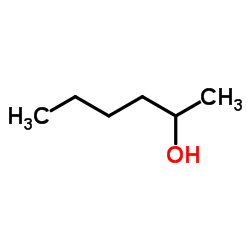2-Hexanol

2-Hexanol structure
|
Common Name | 2-Hexanol | ||
|---|---|---|---|---|
| CAS Number | 626-93-7 | Molecular Weight | 102.175 | |
| Density | 0.8±0.1 g/cm3 | Boiling Point | 139.7±3.0 °C at 760 mmHg | |
| Molecular Formula | C6H14O | Melting Point | -23ºC | |
| MSDS | Chinese USA | Flash Point | 46.1±0.0 °C | |
| Symbol |


GHS02, GHS07 |
Signal Word | Warning | |
|
Convenient QSAR model for predicting the complexation of structurally diverse compounds with β-cyclodextrins
Bioorg. Med. Chem. 17 , 896-904, (2009) This paper reports a QSAR study for predicting the complexation of a large and heterogeneous variety of substances (233 organic compounds) with beta-cyclodextrins (beta-CDs). Several different theoretical molecular descriptors, calculated solely from the mole... |
|
|
Changes of n-hexane metabolites in urine of rats exposed to various concentrations of n-hexane and to its mixture with toluene or MEK.
Int. Arch. Occup. Environ. Health 53(1) , 1-8, (1983) It is well known that n-hexane produces peripheral neuropathy, and 2,5-hexanedione, one of the metabolites of n-hexane, is thought to be the main causative agent. Recently, the metabolites of n-hexane in urine have been measured by gas chromatography, and 2,5... |
|
|
Two-chiral-component microemulsion electrokinetic chromatography-chiral surfactant and chiral oil: part 1. dibutyl tartrate.
Electrophoresis 28(11) , 1723-34, (2007) The first simultaneous use of a chiral surfactant and a chiral oil for microemulsion EKC (MEEKC) is reported. Six stereochemical combinations of dodecoxycarbonylvaline (DDCV: R, S, or racemic, 2.00% w/v), racemic 2-hexanol (1.65% v/v), and dibutyl tartrate (D... |
|
|
Chiral microemulsion electrokinetic chromatography with two chiral components: Improved separations via synergies between a chiral surfactant and a chiral cosurfactant.
Electrophoresis 27(4) , 896-904, (2006) In this study, the combination of two chiral components in a microemulsion formulation for the separation of enantiomers via microemulsion EKC (MEEKC) was successfully accomplished. Previous publications of chiral microemulsions have utilized only one chiral ... |
|
|
[An experimental study on the neurotoxicity of 2-octanone and 2-hexanol, a metabolite of n-hexane].
Sangyo. Igaku. 24(5) , 475-84, (1982) An electrophysiological study of the neurotoxicity of 2-octanone (an analogue of methyl n-butyl ketone) and 2-hexanol (a metabolite of n-hexane) was conducted on rats as a part of the study to determine the specific molecular arrangement required for the deve... |
|
|
Differential involvement of glutamate-gated chloride channel splice variants in the olfactory memory processes of the honeybee Apis mellifera.
Pharmacol. Biochem. Behav. 124 , 137-44, (2014) Glutamate-gated chloride channels (GluCl) belong to the cys-loop ligand-gated ion channel superfamily and their expression had been described in several invertebrate nervous systems. In the honeybee, a unique gene amel_glucl encodes two alternatively spliced ... |
|
|
Effects of n-hexane and its metabolites on cloned voltage-operated neuronal potassium channels.
Arch. Toxicol. 71(4) , 238-42, (1997) In order to study the mechanisms of acute n-hexane intoxication, the effects of n-hexane and its metabolites 2-hexanol, methyl-n-butyl ketone, 2,5-hexanediol and 2,5-hexanedione on the cloned voltage-operated potassium channels Kv1.1, Kv1.4, Kv2.1 and Kv3.4 w... |
|
|
Metabolism of n-hexane by rat liver and extrahepatic tissues and the effect of cytochrome P-450 inducers.
Hum. Exp. Toxicol. 16(3) , 131-7, (1997) 1. The in vitro metabolism of n-hexane was studied in rat liver, lung, brain and skeletal muscle microsomes and in microsomes prepared from cell lines expressing human cytochrome P-450 2E1 or 2B6. The hydroxylated metabolites of n-hexane were quantified by ga... |
|
|
An investigation into the role of rat skeletal muscle as a site for xenobiotic metabolism using microsomes and isolated cells.
Hum. Exp. Toxicol. 16(3) , 138-45, (1997) 1. The role of skeletal muscle microsomes as a site of extrahepatic xenobiotic metabolism using n-hexane as a model substrate was investigated. The observed cytochrome P450-dependent metabolism was compared with that found with liver, and brain microsomal fra... |
|
|
Olfactory discrimination of structurally similar alcohols by cockroaches.
J. Comp. Physiol. A. Neuroethol. Sens. Neural. Behav. Physiol. 188(10) , 787-97, (2002) The capability of the cockroach Periplaneta americana to discriminate odors of structurally similar aliphatic alcohols was studied by using an operant conditioning paradigm. Cockroaches were trained to discriminate three odors: one odor associated with sucros... |